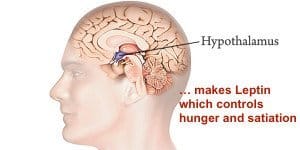3 Reasons Leptin Resistance Made You Fat and What To Do About It

There are reasons you’re fat. Some are obvious. One may not be. It’s called leptin resistance, which basically means that the hormone that tells you when to stop eating is malfunctioning. Here’s how to tell if that’s your issue and what to do about it. [Watch]
ATTENTION! THIS just out – there’s an “off switch” for obesity and it resides in your very own brain.
A paper published in the latest edition of the journal Science tells us that a key enzyme called O-GlcNAc  transferase (“OGT”) produced in our brain’s hypothalamus is not only involved in insulin signaling (how our bodies deal with sugar/carbs), but strongly influences appetite.
transferase (“OGT”) produced in our brain’s hypothalamus is not only involved in insulin signaling (how our bodies deal with sugar/carbs), but strongly influences appetite.
At least with mice.
Yes, we’re back to those pesky mice, given that they complain less than do humans when put in cages, poked, prodded and messed with. But that’s OK (if you’re not a mouse), because much of what is learned by manipulating mice can be inferred to the biology of humans.
Olof Lagerlöf and his colleagues at John Hopkins University designed their very own special mice that did not have OGT. These no-OGT mice ate as frequently as the unmodified mice, but consumed twice as much food, spent longer periods of time eating and quickly became obese. Within three weeks, the no-OGT mice tripled their amount of body fat. (1)
At this point, whether a mouse or not, as you glance down at your belly you might be wondering if this leptin thing has anything to do with what’s protruding?
Pro·trud·ing (adjective): Sticking out; projecting.
In all likelihood, it does.
How Do You Know If You’re Leptin Resistant?
Before we dance around that question, let’s get a better understanding about leptin. Any Greek worth his salt will tell you that the word “leptin” comes from the work Leptos, which means “thin.” Now that’s a really good tip, because if your body is functioning properly leptin will give satiety signals that basically tells you it’s time to stop eating before you burst.
If your leptin is giving off that signal and if you respond to it (like dropping your fork) you’re likely to be thin (“leptos”). If your grip on that fork is unyielding as you continue to plunge it into that overflowing bowl of pasta, well you’re in good company given that about two-thirds of the industrialized world’s people are overweight. (Extra credit to the Japanese, given that only one-quarter of them are overweight (2).)
The problem is that once overweight, the body wants to stay that way.
In the case of leptin, the amount of it released is dependent upon how much fat you have – the more fat, the more leptin. Kinda like the more high glycemic carbs you eat (those that quickly elevate blood sugar), the more insulin is produced. And in both cases, the more these two hormones surge throughout your body, the less responsive you will become to them.
You become resistant.
You become resistant to the leptin signals to stop eating, just as the body becomes resistant to the insulin. In both cases, a whole host of unhappy physiological conditions transpire, perhaps the most noticeable being weight gain. Leptin resistance results in eating more calories than expended, and insulin resistance means that blood sugar is not used for energy, but to make fat the big offenders eventually get adult onset (type 2) diabetes.
OK, all that said, let’s give you some ways to check if you’re leptin resistance, which have been culled from articles by Dr. Jack Kruse, NYALife and Authority Nutrition.
Three basic tips that you’re leptin resistant:
1. The mirror says your fat.
Get naked, stand in front of some big mirror hanging on the wall whilst you clutch a hand-held mirror in your trembling hand. Take a big breath and look at yourself. Then slowly turn around as you manipulate the hand-held mirror so you can see your glorious backside.
If you’re overweight, say by 15-plus pounds, you’re likely to be leptin resistant.
Also, if you’re underweight by the same amount, you’re likely to be leptin resistant.
2. You crave carbs and have a large appetite.
If you have a large appetite and crave carbohydrates, especially at night, you are likely to be Leptin resistant.
3. You have thyroid or cortisol issues.
If you often have cold hands and feet, are overweight and have a cold body temperature, you may have a thyroid problem. If you’re often stressed and agitated, you may have a cortisol problem. Either way, you’ll need a blood or saliva test to tell the tale. If either one it true, it may be contributing to leptin resistance.
Given all that, do you think you’re leptin resistant? If so, watch this, then read on…
What You Can Do To Regain Leptin Sensitivity
There’s lots you can do to get leptin sensitive, but what you don’t want to do is get overwhelmed. Go over the following list and choose one or two to do this week, and then add more the following week, etc.
Eat protein in the morning, some fat and minimize carbs.
Within 30 minutes of arising, get from 30 grams (not so fat) to 75 grams (really fat) of protein. It’s better if the source is food, like eggs or meat from pasture-fed chickens or cows, poultry and fish, particularly salmon.
It’s fine if you rather get your protein from powders, but make select from hemp, sprout or pea protein powders. Whey is an excellent protein source post-exercise, but gets absorbed too quickly (spikes insulin too much) otherwise.
Keep your carbs to 25 grams if overweight by 30-plus pounds, and don’t get them from potatoes or rice.
Get your fats from avocado, fish oil and coconut oil while you’re regaining your leptin sensitivity.
You’ll know if you’re eating enough protein by monitoring your hunger. If you could skip lunch if you needed to without feeling like you’re starving, then you’re getting enough protein in your morning meal.
Don’t snack, period.
When leptin resistant, your liver needs to re-learn how to use gluconeogenesis normally again. Snacking destroys the timing and circadian clocks that work in conjunction with Leptin.
Eat three meals, or two — that’s it.
In the beginning, since you’re not snacking you might want to get in three meals each day, but you may find that your hunger and cravings fade and that two meals becomes sufficient.
Don’t eat before sleep.
Finish your dinner a good three hours or more before it’s time to go to bed. If you’re accustomed to snacking before bed, simply lay out a plan to increase the duration between post-dinner snacks and bedtime, say ½ hour every few days.
Exercise.
Resistance training and high intensity interval training (“HIIT”) help to regain leptin sensitivity, not to mention builds muscle, which increases metabolism, which helps you lose fat, etc.
If you’re overweight 30-plus pounds, your resistance training may be your body weight alone. Stand up and down from the floor as many times as you can, rest three minutes and do it again. As you get stronger, rest two minutes, then one. Try push-ups, squats. As you get stronger, do them slower for one set and more explosively the next set.
If you’re not overweight by much, or are underweight, use a barbell or dumbbells. Read Get Functionally Fit Forever for a routine to try.
Although a HIIT program is very helpful, if you’re very overweight you must be careful not to injure yourself. Sprinting is not suggested. Perhaps walking stairs till you’re panting hard will suffice. Do them in sets with only enough rest to catch your breath. Get clearance from your doctor. Read a few articles I’ve written about HIIT here.
One last point, for reasons I’m unclear about, Dr. Kruse suggests that to regain leptin sensitivity, it’s best done after 5 PM.
Get Sleep.
Eight hours of restful, rejuvenating sleep. If this is hard to do, take 2 to 5 milligrams of sublingual melatonin before be and/or do three to five minutes of body weight exercises right before bedtime (pushups and squats).
You can also go to Youtube and search for binaural and/or isochronic tones and listen them with headphones – very relaxing.
Make sure the environment is very dark. No luminescence from screens, clocks, phones. Wear an eye make if necessary. (I do.)
Supplement with omega-3 fatty acids and ALCAR.
Dr. Kruse advises his leptin resistant patients to supplement with prescription grade fish oil. There are lemon, orange and mint flavors to help you not gag, and of course you can take gel capsules. If still not convinced, other sources of omega-3 fatty acids include flax seed, walnuts, sardines and salmon. (3)
ALCAR is shorthand for the antioxidant Acetyl-L-carnitine. In rats it’s been shown to reduce leptin resistance, as well as improve energy production (ATP) in skeletal muscle. (4)
Not a rat? Try it anyway.
Avoid processed foods.
Highly processed foods may compromise the integrity of the gut and promote inflammation.
Eat Soluble Fiber.
Eating soluble fiber can help improve gut health and may protect against obesity.
Lower your triglycerides.
Having high blood triglycerides can prevent the transport of leptin from blood and into the brain. One good way to lower triglycerides is to reduce carbohydrate intake
Signs that you’ve regained leptin sensitivity
You looked in the mirror, noted the snacking and late night carb binging and decided that you’re leptin resistant. Rather than shrug and continue to eat yourself into oblivion, you got on a program of eating your morning protein, doing resistance training, swigging down some fish oil, etc.
Now what?
Well, there are signs that you becoming leptin sensitive, such as:
- You’ve lost weight.
- You’re not frequently hungry; in fact you can go many hours without needing to eat.
- You’re calmer and sleep better, and feel refreshed and energized in the morning.
- You recover faster from exercise.
- You have more energy.
All I have to say to that is a hearty CONGRATULATIONS!
Now go help a friend do the same.
Last Updated on February 25, 2024 by Joe Garma




